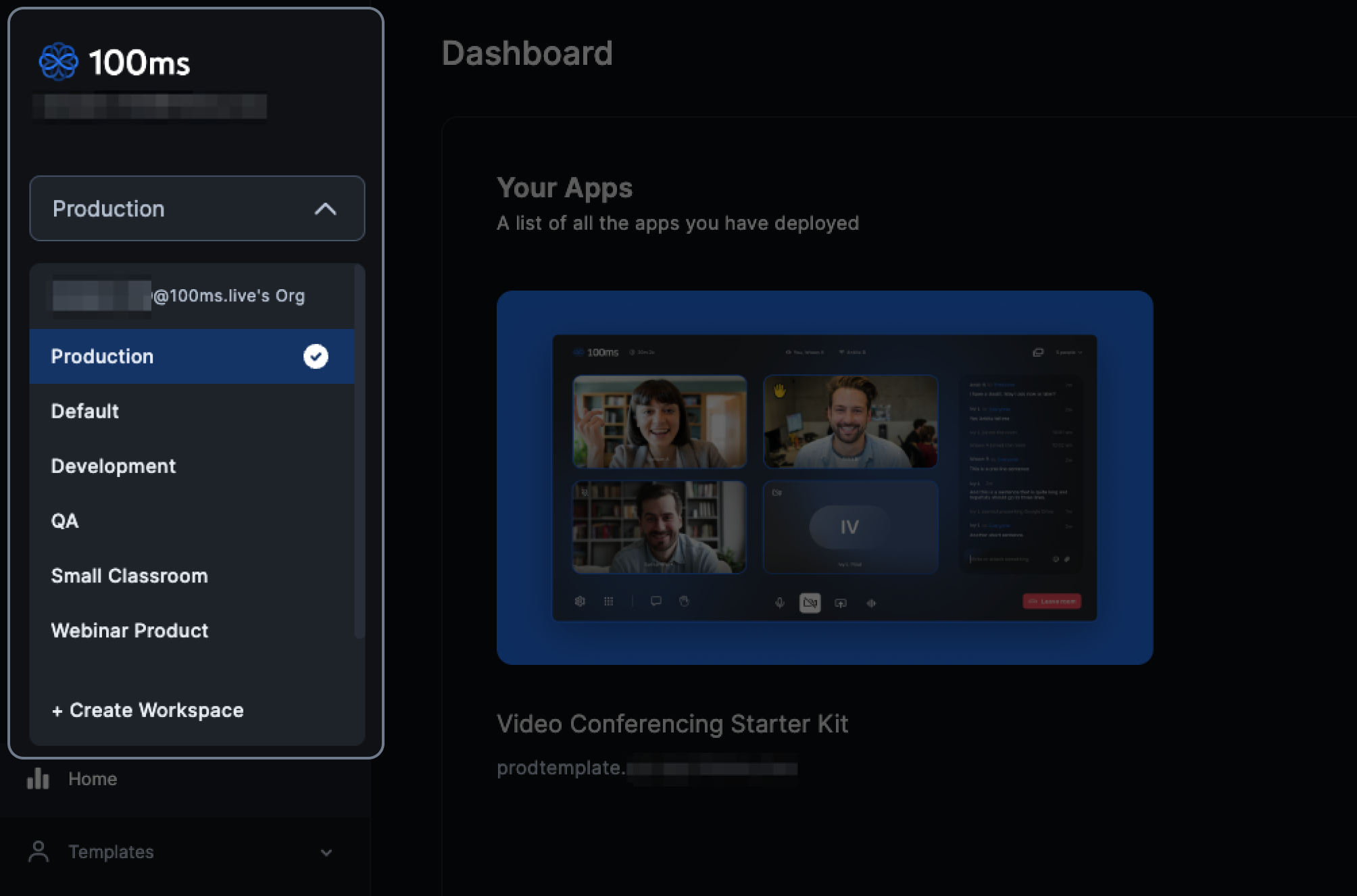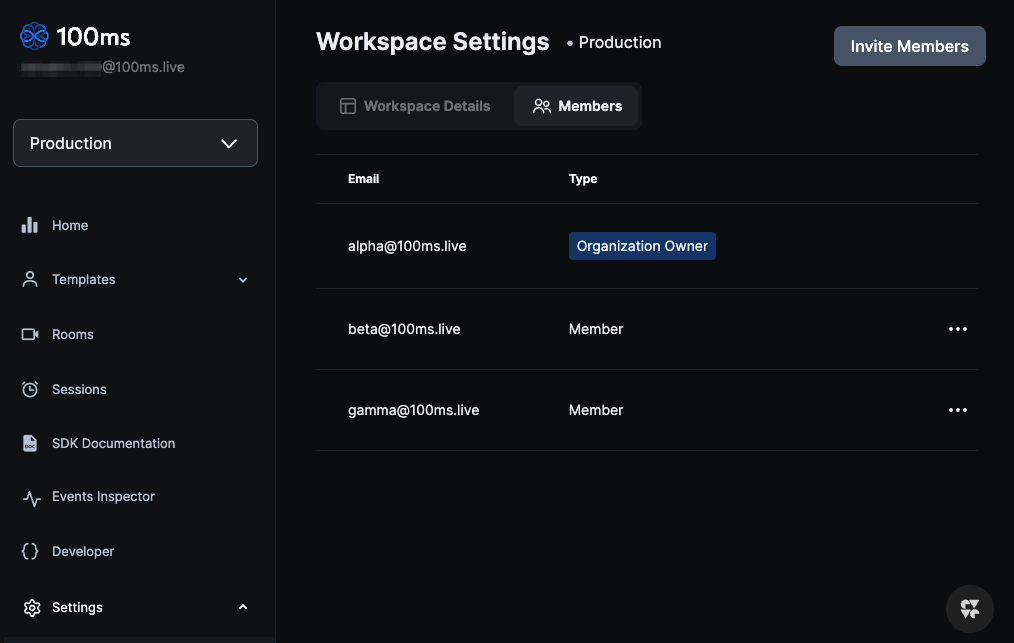Home
/ Blog /
Launching Teams and WorkspacesLaunching Teams and Workspaces
December 19, 20223 min read
Share
Rishabh Agnihotri
Product Manager
Hardik Maheshwari
Software Engineer
Ritik Agarwal
Software Engineer
Rajeev Kumar
Staff Software Engineer
Saikat Mitra
Engineering Director
Shubham Prasad
Software Engineer
Sandeep Mishra
Software Engineer
Piyush Bansal
Software Engineer
Chris Brendan
Product Designer
Ajun Ravi
Software Engineer
Developers use 100ms SDKs to build diverse live video features in their apps. Imagine features that enable a virtual classroom, a telehealth consultation, or virtual visits to real estate locations. Unlike standalone apps like Zoom or Google Meet, features built with 100ms are deeply integrated within an app. This integration is possible through a collaboration of multiple developers in a team: web or mobile developers build feature UI, and backend developers set up authentication with 100ms tokens.
Features built with 100ms need to work in different deployment environments, with a clean separation between development and production so that experimentation during development does not affect production.
Until yesterday, the only way to achieve this setup was to create different accounts on 100ms and share access with your colleagues—not ideal, to say the least. To fix this and enable these scenarios better, the 100ms dashboard now supports “workspaces” that enable isolated deployment environments and team collaboration within them. Head over to your dashboard account to try it out now!
This was a highly requested feature by many of you, and we appreciate your patience and feedback that helped us ship this. Let’s take a deeper look at workspaces in this blog post.
Workspaces
A workspace is an isolated environment which acts as a container for your templates and rooms. Usage and activity data of templates and rooms are stored in a workspace. You can create or switch to a workspace using the workspace switcher on the top-left section of your dashboard. These workspaces belong to a single organization account.

Workspace-level tokens and webhooks
Each workspace has a set of respective access key and secret for generation of tokens. This separation of tokens per workspace enables you to control access for different environments.
Just like tokens, each workspace has its own webhook configuration. This enables you to define different webhook endpoints for each workspace and distinguish events from different deployment environments. The tokens and webhook configuration for a workspace are available in the developer section of your dashboard.
To understand workspaces better, let’s take an example use case: creating development and production environments. Create a workspace for development and another workspace for production. Your access key, secret and webhook configuration will be distinct for these two environments.
As another example, you can also create separate workspaces for different product offerings. Let’s say you have two product offerings: a small classroom which runs on video conferencing and a webinar classroom which runs on live streaming. You can create workspaces for each of these products and add members of those teams into the respective workspaces.
Take your first step in exploring this feature by creating a new workspace or changing the name of your default workspace in workspace settings.
Workspace members
You can now add members to each of your workspaces to create workspace-specific teams. Members are specific to a workspace and won’t show up in other workspaces unless explicitly added.

Members who belong to a workspace will have the ability to edit templates, create rooms, and modify settings based on their membership type. The following table outlines available membership types and their respective access permissions.
| Member Type | Rooms (Create or modify) | Templates (Create or modify) | Developer Configuration | Workspace Settings | Organization Settings | Billing |
|---|---|---|---|---|---|---|
| Organization Owner | ✅ | ✅ | ✅ | ✅ | ✅ | ✅ |
| Workspace Admin | ✅ | ✅ | ✅ | ✅ | ❌ | ❌ |
| Workspace Member | ✅ | ✅ | ❌ | ❌ | ❌ | ❌ |
Get started by inviting members to your workspace.
What’s coming up next
With today’s release, workspaces are available for you to try out. Here’s a sneak peek at what’s coming in subsequent releases.
- Workspace Admin as a new member type for more granular access control
- Ability to clone templates across workspaces, so that you can upgrade template config changes to production
- Ability to delete workspaces
- Auto-add members to a workspace for the same work domain
- Migration support for existing multiple accounts into workspaces of a single organization account
Do you have a preferred feature from the list above? Are we missing something? Want to try out an early preview of one of these features? Drop us a line at hello@100ms.live
Product & news
Rishabh Agnihotri
Hardik Maheshwari
Ritik Agarwal
Rajeev Kumar
Saikat Mitra
Shubham Prasad
Sandeep Mishra
Piyush Bansal
Chris Brendan
Ajun Ravi
Share
Related articles
See all articles